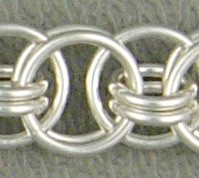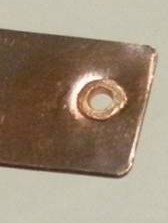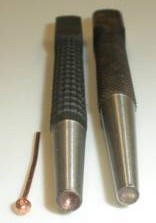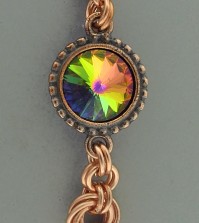- NEW DVD Series – Stone Setting with Bezels
- Tube Set Charm by Kim St. Jean
- Prong Basket Pendant by Kim St. Jean
- NEW DVD Series – Stone Setting with Cold Connections
- New DVD Series – Stone Setting with Wire
- NEW DVD Series: Introduction to Stone Setting by Kim St. Jean
- Featured Tool: Bracelet Bending Plier
- NEW Dvd by Eva Sherman
- Fun, Fast Fold Forming DVD Series
- Double Band Ear Cuff from Alex Simkin
Daily Wire Tip Oct. 28: Wrapping Fossils
Daily Wire Jewelry Making Tip
October 28, 2009
Question:
While in Rockport, Massachusetts, I found an ammonite fossil sliced in half and I would like to wrap them into a pendant together either side by side or up and down. Any ideas??
Answer:
Fossils are such wonderful items to make into jewelry. And what better way to set an ancient relic than to use the age old method of wire wrapping! Besides creating a unique piece of wearable art, setting a specimen in a wire design that uses no solder or glue in the process also protects the value of a piece because no physical damage is done to it. One of my students, Jill made a sliced ammonite pair into a butterfly pendant last year, Lindi used her slices to create a pair of earring that naturally match, someone else showed me a necklace where they had wrapped each individually and then attached them side-by-side on a chain and others have just wrapped each slice individually and made two pendants. I always have several different fossils made into pieces for every show I do, as they attract the attention of people who would not otherwise even look at jewelry!
Answer contributed by Dale `Cougar` Armstrong
Have a question? Submit your question here!























Denise
October 28, 2009 at 4:26 pm
I love the answers you provide but I’m a visual person,,,it would be fantastic if you could include some pictures with your answers. Ths Denise
Lori Walla
October 28, 2014 at 7:08 am
Yeah, I am LOVING that suggestion!
Andrea Taylor
September 14, 2015 at 5:48 am
yes i agree,it’s much better to see things visually,although i can appreciate this takes time,but as a newbie to jewellery making i need to see,thanks so much
Juan M Colon
October 29, 2009 at 10:33 pm
What is an ammonite fossil? I like to know because I may find one by not knowing what is kick to the side.
Trudi
November 2, 2009 at 11:38 pm
a link to an image of amonite fossils: http://en.wikipedia.org/wiki/File:Haeckel_Ammonitida.jpg
they look like snails ….
Jessie Adams
November 3, 2009 at 5:27 pm
Hi All,
Ammonites are extinct creatures that looked similar to the modern day nautilus; but are more closely related to to octopus,squid,& cuttlefish. These beasties are found all over the planet and specimans have been found to over 6 .5 feet in diameter. Wikipedia has a great article on them.
I usual use the ones in matrix that are polished Howard Shalasker Company in Massachusetts is a good source for them.
When I make these into pendants I use half hard wire in a wrapped cinch setting, using the ends of the wire for the loop and embellishment. With my cutomers I find that with fossil pendants, Less is more.
Have fun and keep on wrapping
Jessie Adams
November 3, 2009 at 5:33 pm
update on comment for ammonites in matrix
Howard Schlansker
Address: 166 Enterprise Drive
Marshfield, Massachusetts 02050-2110
Phone: 781-837-6537
Fax: 781-837-6849
and no I don’t work for him; just been a customer for(dare I say it … decades) This is one of the old men of rockdom. No catalog, no internet, no email. You have to call him to find out what’s in stock. Reasonable prices.wholesale.
sarah oneal
December 16, 2009 at 1:48 pm
I enjoyed your coments and information. I hope I will be lucky enough to find a fossil suitable for jewelry. I also agree we need pictures.
Thanks, Sarah Oneal
PS- I am also hooked on beading.
Laverne
October 29, 2014 at 8:26 pm
I always wish/hope your comments will be accompanied by pictures and/or videos. Might you consider doing that?
Laurel
December 29, 2014 at 4:00 pm
Please use pictures in your blog. Some of us artists are disabled and with out pictures are unable to complete the processes in our heads. Thank you from your biggest stroke follower.
Deb
January 28, 2015 at 2:29 pm
For visual examples, google \"wire wrapped ammonite\" and you\’ll see some wonderful examples. There\’s also some videos!
Tonie
August 28, 2015 at 3:32 pm
I love Dale’s advice but I can’t help feeling that something else was needed for the answer to this question. I’m guessing the writer possibly wanted to know what is advised for wire size and hardness? – is there a special way to handle fossils so they don’t get scratched? – is it OK to drill a hole into a fossil? -is there a way to polish, wax or preserve them before wrapping with wire?
At least, those were the answers that I wanted to se when I read the question. Could we get more info, Dale?
Joyce
December 29, 2015 at 8:46 am
Hopefully everyone is aware of the the legal issues involved in collecting fossils as well. If you’re on private property, by permission of course, it is legal to collect. You will need to come to terms with the landowner re: what you can keep. If you’re on public property, you can only keep non-vertebrates (of which ammonites are an example). Every state has its own regulations, and so does the federal government, so do your research before you head out.